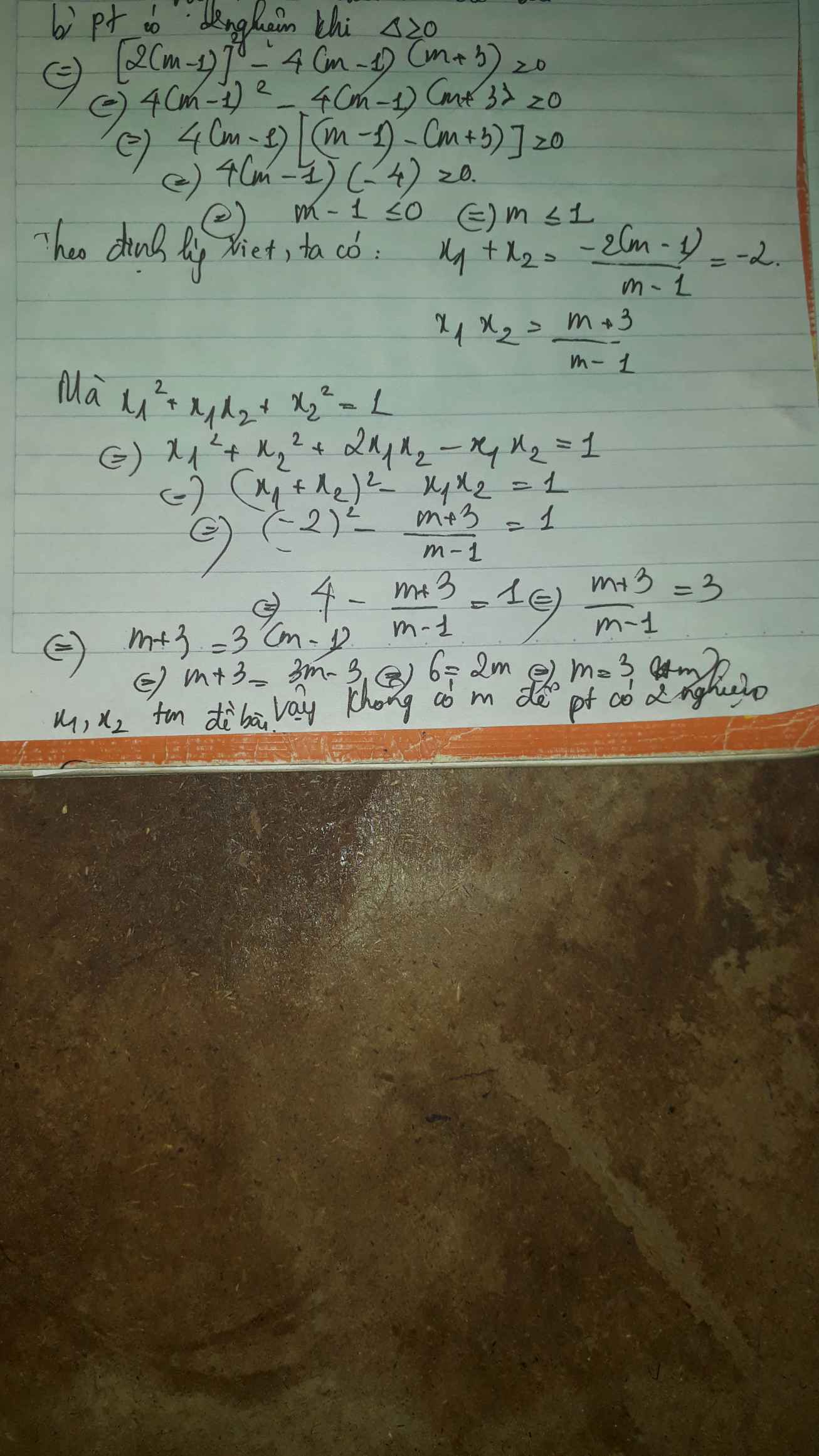Hãy nhập câu hỏi của bạn vào đây, nếu là tài khoản VIP, bạn sẽ được ưu tiên trả lời.

Lời giải:
Xin chỉnh sửa lại chút, tìm $k$, chứ không phải tìm $m$.
PT $\Leftrightarrow x^2-(6k-2)=0\Leftrightarrow x^2=6k-2$
Để pt có 2 nghiệm phân biệt thì $6k-2>0\Leftrightarrow k>\frac{1}{3}$
Khi đó:
$x_1=\sqrt{6k-2}$ và $x_2=-\sqrt{6k-2}$
Để $3x_1-x_2=2$
$\Leftrightarrow 3\sqrt{6k-2}+\sqrt{6k-2}=2$
$\Leftrightarrow \sqrt{6k-2}=\frac{1}{2}\Rightarrow k=\frac{3}{8}$

b) phương trình có 2 nghiệm \(\Leftrightarrow\Delta'\ge0\)
\(\Leftrightarrow\left(m-1\right)^2-\left(m-1\right)\left(m+3\right)\ge0\)
\(\Leftrightarrow m^2-2m+1-m^2-3m+m+3\ge0\)
\(\Leftrightarrow-4m+4\ge0\)
\(\Leftrightarrow m\le1\)
Ta có: \(x_1^2+x_1x_2+x_2^2=1\)
\(\Leftrightarrow\left(x_1+x_2\right)^2-2x_1x_2=1\)
Theo viet: \(\left\{{}\begin{matrix}x_1+x_2=-\dfrac{b}{a}=2\left(m-1\right)\\x_1x_2=\dfrac{c}{a}=m+3\end{matrix}\right.\)
\(\Leftrightarrow\left[-2\left(m-1\right)^2\right]-2\left(m+3\right)=1\)
\(\Leftrightarrow4m^2-8m+4-2m-6-1=0\)
\(\Leftrightarrow4m^2-10m-3=0\)
\(\Leftrightarrow\left[{}\begin{matrix}m_1=\dfrac{5+\sqrt{37}}{4}\left(ktm\right)\\m_2=\dfrac{5-\sqrt{37}}{4}\left(tm\right)\end{matrix}\right.\Rightarrow m=\dfrac{5-\sqrt{37}}{4}\)

a/ Xét phương trình : \(x^2-2\left(k-1\right)x+2\left(k-2\right)=0\)
Ta có :
\(\Delta'=b'^2-ac=\left(k-1\right)^2-2\left(k-2\right)=k^2-2k+1-2k+4=k^2-4k+5=\left(k-2\right)^2+1>0\forall k\)
\(\Leftrightarrow\) Phương trình luôn có 2 nghiệm phân biệt với mọi k
b/ Theo định lí Vi - ét ta có :
\(\left\{{}\begin{matrix}x_1+x_2=\dfrac{-b}{a}=2\left(k-1\right)\\x_1.x_2=\dfrac{c}{a}=2\left(k-2\right)\end{matrix}\right.\)
\(\left|x_1\right|+\left|x_2\right|=4\)
\(\Leftrightarrow\left(\left|x_1\right|+\left|x_2\right|\right)^2=16\)
\(\Leftrightarrow x_1^2+x_2^2+2\left|x_1.x_2\right|=16\)
\(\Leftrightarrow x_1^2+x_2^2+4\left(k-2\right)=16\)
\(\Leftrightarrow\left(x_1+x_2\right)^2-2x_1.x_2+4k-8=16\)
\(\Leftrightarrow4\left(k-1\right)^2-4\left(k-2\right)+4k-8=16\)
\(\Leftrightarrow4k^2-8k+4-4k+8+4k-8=0\)
\(\Leftrightarrow k=\pm3\)
Vậy....

a, Thay \(m=-3\) vào \(\left(1\right)\)
\(x^2-2.\left(m-1\right)x-m-3=0\\ \Leftrightarrow x^2-2.\left(-3-1\right)x+3-3=0\\ \Leftrightarrow x^2+8x=0\\ \Leftrightarrow x\left(x+8\right)=0\\ \Leftrightarrow\left[{}\begin{matrix}x=0\\x=-8\end{matrix}\right.\)
Vậy với \(m=-3\) thì \(x=0;x=-8\)
b,
\(\Delta'=\left[-\left(m-1\right)\right]^2-1.\left(-m-3\right)\\ =m^2-2m+1+m+3\\ =m^2-m+4\)
phương trình có hai nghiệm phân biệt
\(\Delta'>0\\ m^2-m+4>0\\ \Rightarrow m^2-2.\dfrac{1}{2}m+\dfrac{1}{4}+\dfrac{7}{2}>0\\ \Leftrightarrow\left(m-\dfrac{1}{2}\right)^2+\dfrac{7}{2}>0\left(lđ\right)\)
\(\Rightarrow\forall m\)
Áp dụng hệ thức Vi ét :
\(\left\{{}\begin{matrix}x_1+x_2=2\left(m-1\right)\\x_1x_2=-m-3\end{matrix}\right.\)
\(\left(x_1-x_2\right)^2=4m^2-5\left(x_1+x_2\right)\\ \Leftrightarrow x_1^2+2x_1.x_2+x^2_2-4x_1x_2=4m^2-5\left(x_1+x_2\right)\\ \Leftrightarrow\left(x_1+x_2\right)^2-4x_1x_2=4m^2-5\left(x_1+x_2\right)\\ \Leftrightarrow\left(2.\left(m-1\right)\right)^2-4.\left(-m-3\right)=4m^2-5.\left(-m-3\right)\\ \Leftrightarrow4m^2-8m+4+4m+12-4m^2-5m-15=0\\ \Leftrightarrow-9m+1=0\\ \Leftrightarrow m=\dfrac{1}{9}\)
Vậy \(m=\dfrac{1}{9}\)
a.
Thế m = -3 vào phương trình (1) ta được:
\(x^2-2\left(-3-1\right)x-\left(-3\right)-3=0\)
\(\Leftrightarrow\) \(x^2+8x=0\)
\(\Leftrightarrow x\left(x+8\right)=0\\ \Rightarrow x_1=0,x_2=-8\)
b.
Để phương trình (1) có hai nghiệm phân biệt thì:
\(\Delta>0\\ \Leftrightarrow\left[-2\left(m-1\right)\right]^2-4.1.\left(-m-3\right)>0\)
\(\Leftrightarrow4.\left(m^2-2m+1\right)+4m+12>0\)
\(\Leftrightarrow4m^2-8m+4+4m+12>0\)
\(\Leftrightarrow4m^2-4m+16>0\)
\(\Leftrightarrow\left(2m\right)^2-4m+1+15>0\)
\(\Leftrightarrow\left(2m-1\right)^2+15>0\)
Vì \(\left(2m-1\right)^2\) luôn lớn hơn hoặc bằng 0 với mọi m nên phương trình (1) có nghiệm với mọi m.
Theo viét:
\(\left\{{}\begin{matrix}x_1+x_2=2m-2\\x_1x_2=-m-3\end{matrix}\right.\) (I)
có:
\(\left(x_1-x_2\right)^2=4m^2-5x_1+x_2\)
<=> \(x_1^2-2x_1x_2+x_2^2-4m^2+5x_1-x_2=0\)
<=> \(x_1^2-2x_1x_2+x_2^2+2x_1x_2-2x_1x_2-4m^2+5x_1-x_2=0\)
<=> \(\left(x_1+x_2\right)^2-4x_1x_2-4m^2+5x_1-x_2=0\)
<=> \(\left(2m-2\right)^2-4.\left(-m-3\right)-4m^2+5x_1-x_2=0\)
<=> \(4m^2-8m+4+4m+12-4m^2+5x_1-x_2=0\)
<=> \(-4m+16+5x_1-x_2=0\)
<=> \(5x_1-x_2=4m-16\) (II)
Từ (I) và (II) ta có:
\(\left\{{}\begin{matrix}5x_1-x_2=4m-16\left(2\right)\\x_1+x_2=2m-2\left(3\right)\\x_1x_2=-m-3\left(4\right)\end{matrix}\right.\)
Từ (2) ta có:
\(x_1=\dfrac{4m-16+x_2}{5}=\dfrac{4}{5}m-3,2+\dfrac{1}{5}x_2\) (x)
Thế (x) vào (3) được:
\(\dfrac{4}{5}m-3,2+\dfrac{1}{5}x_2+x_2=2m-2\)
<=> \(\dfrac{4}{5}m-3,2+\dfrac{1}{5}x_2+x_2-2m+2=0\)
<=> \(-1,2m-1,2+1,2x_2=0\)
<=> \(x_2=1,2m+1,2\) (xx)
Thế (xx) vào (3) được:
\(x_1+1,2m+1,2=2m-2\)
<=> \(x_1+1,2m+1,2-2m+2=0\)
<=> \(x_1-0,8m+3,2=0\)
<=> \(x_1=-3,2+0,8m\) (xxx)
Thế (xx) và (xxx) vào (4) được:
\(\left(-3,2+0,8m\right)\left(1,2m+1,2\right)=-m-3\)
<=> \(-3,84m-3,84+0,96m^2+0,96m+m+3=0\)
<=> \(0,96m^2-1,88m-0,84=0\)
\(\Delta=\left(-1,88\right)^2-4.0,96.\left(-0,84\right)=6,76\)
\(m_1=\dfrac{1,88+\sqrt{6,76}}{2.0,96}=\dfrac{7}{3}\left(nhận\right)\)
\(m_2=\dfrac{1,88-\sqrt{6,76}}{2.0,96}=-\dfrac{3}{8}\left(nhận\right)\)
T.Lam

Δ=(m+2)^2-4*2m
=m^2+4m+4-8m
=(m-2)^2>=0
Để PT luôn có hai nghiệm phân biệt thì m-2<>0
=>m<>2
\(\left(x_1+x_2\right)^2-x_1x_2< =3\)
=>(m+2)^2-2m<=3
=>m^2+4m+4-2m-3<=0
=>m^2+2m+1<=0
=>(m+1)^2<=0
=>m=-1

Ta có △=\(b^2-4ac>0\Leftrightarrow\left[-2\left(k-1\right)\right]^2-4.1.\left(-4k\right)>0\Leftrightarrow4k^2-8k+4+16k^2>0\Leftrightarrow20k^2-8k+4>0\Leftrightarrow5k^2-2K+1>0\)(luôn đúng)
Vậy phương trình luôn có 2 nghiệm phân biệt với mọi k\(\in R\)
Theo định lí Vi-ét ta có \(\left\{{}\begin{matrix}x_1+x_2=\frac{-b}{a}=\frac{2k-2}{1}=2k-2\\x_1x_2=\frac{c}{a}=\frac{-4k}{1}=-4k\end{matrix}\right.\)
Mà ta có\(3x_1-x_2=2\Leftrightarrow3x_1+3x_2-4x_2=2\Leftrightarrow3\left(x_1+x_2\right)-4x_2=2\Leftrightarrow3\left(2k-2\right)-4x_2=2\Leftrightarrow6k-6-2=4x_2\Leftrightarrow6k-8=4x_2\Leftrightarrow x_2=\frac{3k-4}{2}\)
\(\Rightarrow x_1=2k-2-\frac{3k-4}{2}=\frac{4k-4-3k+4}{2}=\frac{k}{2}\)
Vậy \(x_1x_2=-4k\Leftrightarrow\frac{k}{2}.\frac{3k-4}{2}=-4k\Leftrightarrow3k^2-4k=-16k\Leftrightarrow3k^2+12k=0\Leftrightarrow k\left(k+4\right)=0\Leftrightarrow\)\(\left[{}\begin{matrix}k=0\\k=-4\end{matrix}\right.\)
Vậy k=0 hoặc k=-4 thì phương trình có 2 nghiệm phân biệt \(x_1,x_2\) thỏa mãn \(3x_1-x_2=2\)